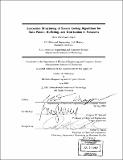| dc.contributor.advisor | Gregory W. Wornell. | en_US |
| dc.contributor.author | Draper, Stark Christiaan | en_US |
| dc.contributor.other | Massachusetts Institute of Technology. Dept. of Electrical Engineering and Computer Science. | en_US |
| dc.date.accessioned | 2005-10-14T19:22:45Z | |
| dc.date.available | 2005-10-14T19:22:45Z | |
| dc.date.copyright | 2002 | en_US |
| dc.date.issued | 2002 | en_US |
| dc.identifier.uri | http://hdl.handle.net/1721.1/29239 | |
| dc.description | Thesis (Ph. D.)--Massachusetts Institute of Technology, Dept. of Electrical Engineering and Computer Science, 2002. | en_US |
| dc.description | Includes bibliographical references (p. 159-165). | en_US |
| dc.description.abstract | Numerous opportunities to improve network performance present themselves when we make communication networks aware of the characteristics of the data content they are handling. In this thesis, we design such content-aware algorithms that span traditional network layers and are successively structured, focusing on problems of data fusion, buffering, and distribution. The successive structuring of these algorithms provides the flexibility needed to deal with the distributed processing, the heterogeneous sources of information, and the uncertain operating conditions that typify many networks. We investigate the broad interactions between estimation and communication in the context of data fusion in tree-structured sensor networks. We show how to decompose any general tree into serial (pipeline) and parallel (hub-and-spoke) networks. We develop successive coding strategies for these prototype sensor networks based on generalized Wyner-Ziv coding. We extend Wyner-Ziv source coding with side information to "noisy" encoder observations and develop the associated rate-distortion function. We show how to approach the serial and parallel network configurations as cascades of noisy Wyner-Ziv stages. This approach leads to convenient iterative (achievable) distortion-rate expressions for quadratic-Gaussian scenarios. Under a sum-rate constraint, the parallel network is equivalent to what is referred to as the CEO problem. We connect our work to those earlier results. We further develop channel coding strategies for certain classes of relay channels. | en_US |
| dc.description.abstract | (cont.) We also explore the interactions between source coding and queue management in problems of buffering and distributing distortion-tolerant data. We formulate a general queuing model relevant to numerous communication scenarios, and develop a bound on the performance of any algorithm. We design an adaptive buffer-control algorithm for use in dynamic environments and under finite memory limitations; its performance closely approximates the bound. Our design uses multiresolution source codes that exploit the data's distortion-tolerance in minimizing end-to-end distortion. Compared to traditional approaches, the performance gains of the adaptive algorithm are significant - improving distortion, delay, and overall system robustness. | en_US |
| dc.description.statementofresponsibility | by Stark Christiaan Draper. | en_US |
| dc.format.extent | 165 p. | en_US |
| dc.format.extent | 6835571 bytes | |
| dc.format.extent | 6835377 bytes | |
| dc.format.mimetype | application/pdf | |
| dc.format.mimetype | application/pdf | |
| dc.language.iso | eng | en_US |
| dc.publisher | Massachusetts Institute of Technology | en_US |
| dc.rights | M.I.T. theses are protected by copyright. They may be viewed from this source for any purpose, but reproduction or distribution in any format is prohibited without written permission. See provided URL for inquiries about permission. | en_US |
| dc.rights.uri | http://dspace.mit.edu/handle/1721.1/7582 | |
| dc.subject | Electrical Engineering and Computer Science. | en_US |
| dc.title | Successive structuring of source coding algorithms for data fusion, buffering, and distribution in networks | en_US |
| dc.type | Thesis | en_US |
| dc.description.degree | Ph.D. | en_US |
| dc.contributor.department | Massachusetts Institute of Technology. Department of Electrical Engineering and Computer Science | |
| dc.identifier.oclc | 51547840 | en_US |
